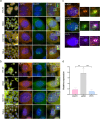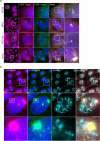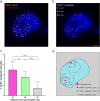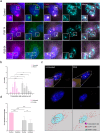CCAT1 lncRNA is chromatin-retained and post-transcriptionally spliced
- PMID: 38763947
- PMCID: PMC11227459
- DOI: 10.1007/s00418-024-02294-w
CCAT1 lncRNA is chromatin-retained and post-transcriptionally spliced
Abstract
Super-enhancers are unique gene expression regulators widely involved in cancer development. Spread over large DNA segments, they tend to be found next to oncogenes. The super-enhancer c-MYC locus forms long-range chromatin looping with nearby genes, which brings the enhancer and the genes into proximity, to promote gene activation. The colon cancer-associated transcript 1 (CCAT1) gene, which is part of the MYC locus, transcribes a lncRNA that is overexpressed in colon cancer cells through activation by MYC. Comparing different types of cancer cell lines using RNA fluorescence in situ hybridization (RNA FISH), we detected very prominent CCAT1 expression in HeLa cells, observed as several large CCAT1 nuclear foci. We found that dozens of CCAT1 transcripts accumulate on the gene locus, in addition to active transcription occurring from the gene. The accumulating transcripts are released from the chromatin during cell division. Examination of CCAT1 lncRNA expression patterns on the single-RNA level showed that unspliced CCAT1 transcripts are released from the gene into the nucleoplasm. Most of these unspliced transcripts were observed in proximity to the active gene but were not associated with nuclear speckles in which unspliced RNAs usually accumulate. At larger distances from the gene, the CCAT1 transcripts appeared spliced, implying that most CCAT1 transcripts undergo post-transcriptional splicing in the zone of the active gene. Finally, we show that unspliced CCAT1 transcripts can be detected in the cytoplasm during splicing inhibition, which suggests that there are several CCAT1 variants, spliced and unspliced, that the cell can recognize as suitable for export.
Keywords: CCAT1; MYC; PVT1; Post-transcriptional splicing; RNA FISH; Transcription site.
© 2024. The Author(s).
Conflict of interest statement
The authors declare no competing interests.
Figures






Similar articles
-
Human colorectal cancer-specific CCAT1-L lncRNA regulates long-range chromatin interactions at the MYC locus.Cell Res. 2014 May;24(5):513-31. doi: 10.1038/cr.2014.35. Epub 2014 Mar 25. Cell Res. 2014. PMID: 24662484 Free PMC article.
-
C-Myc-activated long noncoding RNA CCAT1 promotes colon cancer cell proliferation and invasion.Tumour Biol. 2014 Dec;35(12):12181-8. doi: 10.1007/s13277-014-2526-4. Epub 2014 Sep 4. Tumour Biol. 2014. PMID: 25185650
-
Upregulation of the c-MYC oncogene and adjacent long noncoding RNAs PVT1 and CCAT1 in esophageal squamous cell carcinoma.BMC Cancer. 2023 Jan 9;23(1):34. doi: 10.1186/s12885-022-10464-z. BMC Cancer. 2023. PMID: 36624401 Free PMC article.
-
The functions and oncogenic roles of CCAT1 in human cancer.Biomed Pharmacother. 2019 Jul;115:108943. doi: 10.1016/j.biopha.2019.108943. Epub 2019 May 9. Biomed Pharmacother. 2019. PMID: 31078038 Review.
-
Colon cancer associated transcripts in human cancers.Biomed Pharmacother. 2017 Oct;94:531-540. doi: 10.1016/j.biopha.2017.07.073. Epub 2017 Aug 3. Biomed Pharmacother. 2017. PMID: 28779711 Review.
References
-
- Ahmadiyeh N, Pomerantz MM, Grisanzio C, Herman P, Jia L, Almendro V, He HH, Brown M, Liu XS, Davis M, Caswell JL, Beckwith CA, Hills A, Macconaill L, Coetzee GA, Regan MM, Freedman ML. 8q24 prostate, breast, and colon cancer risk loci show tissue-specific long-range interaction with MYC. Proc Natl Acad Sci U S A. 2010;107(21):9742–9746. doi: 10.1073/pnas.0910668107. - DOI - PMC - PubMed
-
- Alaiyan B, Ilyayev N, Stojadinovic A, Izadjoo M, Roistacher M, Pavlov V, Tzivin V, Halle D, Pan H, Trink B, Gure AO, Nissan A. Differential expression of colon cancer associated transcript1 (CCAT1) along the colonic adenoma-carcinoma sequence. BMC Cancer. 2013;13:196. doi: 10.1186/1471-2407-13-196. - DOI - PMC - PubMed
-
- Barutcu AR, Wu M, Braunschweig U, Dyakov BJA, Luo Z, Turner KM, Durbic T, Lin ZY, Weatheritt RJ, Maass PG, Gingras AC, Blencowe BJ. Systematic mapping of nuclear domain-associated transcripts reveals speckles and lamina as hubs of functionally distinct retained introns. Mol Cell. 2022;82(5):1035–1052 e1039. doi: 10.1016/j.molcel.2021.12.010. - DOI - PubMed
MeSH terms
Substances
Grants and funding
LinkOut - more resources
Full Text Sources

